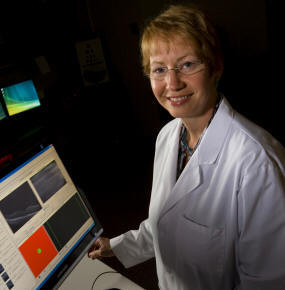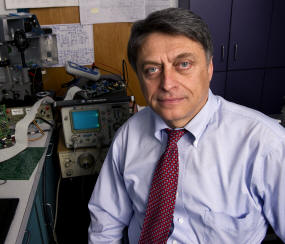2012 Biomedical
Research Collaboration Award
Memphis, TN, November 05, 2012 -- The Hartwell
Foundation officially announced a
Biomedical
Research Collaboration Award to
Cynthia A.
Toth, MD, 2008 Hartwell Investigator and Professor,
Departments of Ophthalmology and Biomedical Engineering,
Duke University and
Boris I.
Gramatikov, Ph.D., 2009 Hartwell Investigator and
Assistant Professor, Department of Ophthalmology, The
Johns Hopkins University for their proposal “Diagnosis
and Management of Infant Retinal Disease: Fast Swept
Source Optical Coherence Tomography Synchronized with
Central Fixation”. The researchers will receive $629,957
in combined direct cost over three years. Both Duke
University and The Johns Hopkins University are named to
the Foundation’s 2012 Top
Ten Centers of Biomedical Research.
Each year in the United States, more than 50,000
children are reported as legally blind, with nearly a
half million reported as having subnormal vision. The
statutory definition of “legally blind” is that central
visual acuity must be 20/200 or less in the better eye
with the best possible correction, or that the visual
field be 20 degrees or less. During the first several
years of life, even temporary interruption in the vision
of one eye can produce severe vision loss, which becomes
less reversible with increasing age. The most common
form of permanent visual impairment originates in the
retina (photosensitive layer at the back of each eye),
which can be caused directly by medications, such as
those for seizures or chemotherapy; in response to
elevated oxygen in treatment of premature birth; the
presence of tumors; and by physical trauma. Because
these disorders of the retina may lead to visual
deficits, it is critical to properly identify and treat
evolving disease prior to permanent damage.
Today, when a retinal condition is suspected in an
infant or toddler, the challenge to the medical
professional is having the child achieve and maintain
visual fixation during an eye exam. This may necessitate
placing the child under general anesthesia to obtain a
precise retinal examination. While undesirable, the
alternatives are to perform a limited examination or
worse, wait until the child grows older to identify what
is wrong. For adults, where visual fixation and
cooperation are usually not an issue, a technology known
as spectral domain optical coherence tomography (OCT) is
available to provide high speed, 3-dimensional, and
magnified images of the retina. This standard of care
for outpatient diagnosis and management of retinal
disease in adults is well-tolerated in older children.
Unfortunately, the size of a conventional OCT device is
too large for deployment in an infant care setting or
for squirming toddlers.
Cynthia Toth is an ophthalmologist and clinical research
scientist at the Duke Eye Center who is a specialist in
the evaluation and surgical treatment of retinal
diseases in children and adults. She is widely
recognized as an expert in retinal imaging with optical
coherence tomography (OCT). As a 2008 Hartwell
Investigator she pioneered the first use of a research
hand-held OCT system for infant examination. While the
imaging device has now been shown to be valuable in the
assessment of premature and newborn infants, the
apparatus must be held less than one inch from the eye
to achieve proper ocular alignment. Infants, active
toddlers and young children will not cooperate for such
imaging without special intervention and thus a more
suitable version of the hand-held OCT instrument that
provides for a more comfortable working distance is
desperately needed.
Boris Gramatikov is a research scientist at The Johns
Hopkins Wilmer Eye Institute. He is a biomedical
engineer with expertise in medical optics, electronic
hardware, computer software and signal processing. His
current research interest is to identify children who
have misaligned eyes and/or unequal refractive error
(amblyopia or “lazy eye”), an otherwise treatable
condition that can cause irreversible blindness. As a
2009 Hartwell Investigator, he developed a noninvasive,
automated vision screening instrument that rapidly and
accurately detects focus and alignment of both eyes
simultaneously, enabling early identification and
treatment of children at risk for amblyopia. His device
is designed to operate conveniently from a distance 12
inches from the eyes by scanning the retina with a spot
of polarized near-infrared light, which takes advantage
of an optical property of the eye known as retinal
birefringence.
It is distressing that treatable visual conditions in
infants and young children are frequently missed because
of a lack of appropriate instrumentation. To meet this
unmet clinical need, Toth and Gramatikov will embark on
a unique collaboration to overcome the limitations of
existing technology. They propose to improve upon the
Toth state-of-the-art handheld OCT imaging device by
developing a swept-source optical coherence tomography
(SSOCT) retinal imaging system that is 10 times faster.
The proposed hand-held SSOCT system will operate within
a comfortable viewing distance from the eyes of the
child and based upon technology offered by Gramatikov,
will automatically detect central fixation (focus and
alignment of both eyes). This new system will have the
unsuspecting infant or child view an “eye-catching”
picture or cartoon on a small LCD computer screen, with
no distracting apparatus between the child and the
screen. The examiner will be able to retain optical
alignment of the SSOCT device with the child’s eye
because invisible polarized light will simultaneously
and automatically detect when the eye is looking at
specific targets on the computer screen.
If Toth and Gramatikov are successful, their technology
will allow for the first time the ability to readily
follow the dynamics of eye development in infants and
toddlers. The availability of such technology will
enable the discovery of critical new diagnostic
information while monitoring longitudinal drug therapy,
which could improve the management of pediatric retinal
disease to eliminate its consequences.
Fostering collaborations between investigators of
complementary scientific strengths is one of the
objectives of The Hartwell
Foundation Mission to fund innovative, early-stage
applied biomedical research with the potential to
benefit children.
|
|

2008 Hartwell Investigator
Cynthia A. Toth, MD,
Duke University

2009 Hartwell Investigator
Boris I. Gramatikov, Ph.D., The Johns Hopkins University
Biomedical Research Collaboration Awards
Individual Biomedical
Research Awards
Top Ten Centers
HOME
|

